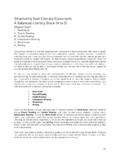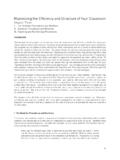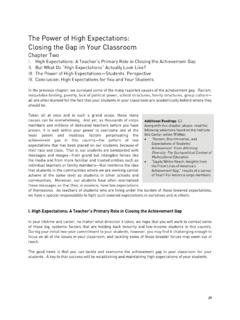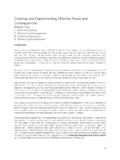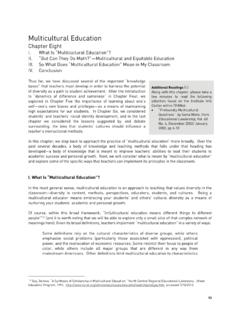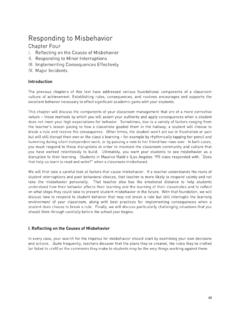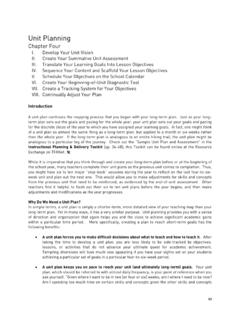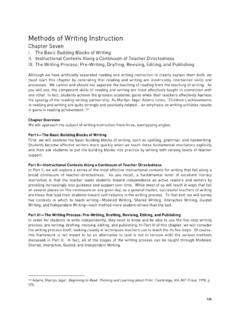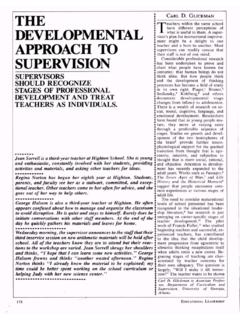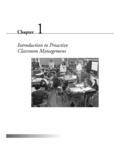Transcription of Lesson Planning, Part I: Standard Lesson Structure
1 77 Lesson planning , part I: Standard Lesson Structure Chapter Five I. The Opening What Students Will Learn and Why It Is Important II. Introduction to New Material The Explicit Explanation III. Guided Practice IV. Independent Practice V. The Closing Stressing Connections and Checking for Understanding Lesson planning Overview Chapters Five, Six, Seven, and Eight The last two chapters of this course introduced you to the bigger-picture maps that teachers make of their year (the long-term plan) and of discrete pieces of their year (the unit plan). This chapter will take your planning skills to a more detailed level, focusing on the day-to-day planning that teachers use to move as efficiently and effectively as possible, on a daily basis, toward the goals laid out in their long-term and unit plans.
2 The next four chapters all concern day-to-day planning and implementation of instruction. Chapter Five gives an overview of the Five-Step Lesson Plan, one of the most effective Lesson structures. Chapter Six explores the instructional tools at your disposal for delivering and meeting your objectives with your students. Chapter Seven equips you with information about key factors that will help you make strategic choices about instructional methods. Chapter Eight considers the difficult but fundamentally important questions surrounding differentiation of your instruction to meet students varied ability levels; in later chapters, we will also focus in particular on supporting English language learners and students with special needs.
3 Introduction The Components of the Five-Step Lesson Plan While schools often require teachers to turn in their Lesson plans and to complete them in a certain format, it is important not to fall into the trap of completing Lesson plans simply to meet the principal s requirement. Rather, you need to plan your lessons in order to ensure that you are taking the most thoughtful approach possible to get your students where you want them to be. Regardless of the particular format your district might require, you will need to be sure that you are making the format work for you, and that you are writing the plan not in order to meet a particular requirement but rather to ensure that your students actually accomplish the objective.
4 Do not be confused by the numerous Lesson plan formats that are accepted and used; variations among them can often be reduced to different terminology and presentation styles. Regardless of format, every effective Lesson plan should build toward the achievement of the objective and connect to long-term instructional goals. It is imperative that all parts of your Lesson plan align to the objective, the Lesson assessment used to measure student mastery of this objective, and, ultimately, your big goal. This alignment focuses your instruction, ensuring that your planning is strategically leading students toward success. The importance of alignment was first introduced in the chapter on long-term and unit plans, and it holds the same value for your Lesson plans as well.
5 Students often acquire knowledge and skills most effectively through the I do, we do, you do approach. This means that teachers first show or model for students what they need to know or be able to do ( I do ). Then students are given adequate time to practice together with assistance of their teacher and peers ( We do ), followed by a period where they attempt to demonstrate mastery of the knowledge and Standard Lesson Structure 78 skills on their own ( You do ). This I do, we do, you do framework serves as the basis for one of the most common Lesson structures - the Five-Step Lesson Plan. Let s look at some of its features.
6 In implementing the Five-Step Lesson Plan you first should ensure your students know what they are about to learn and how that relates to what they know and where they are heading. (We ll call this the Lesson Opening. ) Then you ll want to coach students through the material by drawing on what they already know, presenting them with concise key points and engaging them in activities with varying levels of support to provide greater clarity around the main concept or skill. After providing students with multiple opportunities to practice, you will also measure student understanding of the objective through a formative Lesson assessment.
7 (This is the real heart of the Lesson . We ll call this Introduction to New Material, Guided Practice, and Independent Practice. ) At the end of the Lesson , you should pull everything together and summarize what was learned, so that students leave with a clear understanding of the main concept of the Lesson and how they can apply the concept to future situations. (This we ll call the Lesson Closing. ) Checks for student understanding, a very important piece of each Lesson component, should be woven into each stage. To get started using this format, refer to the Instructional planning & Delivery Toolkit (p. 51: Five-Step Lesson Plan Framework Worksheet ), which can be found online at the Resource Exchange on TFANet.
8 This summer we will look at Lesson planning through a generic lens of a clear beginning, middle and end. The titles in this chart will serve as our common language for the duration of the institute. The Five-Step Lesson Plan is effective because it has many of the features common to all effective Lesson formats. It is important to note that this is only one model that aligns with the qualities of effective Lesson planning and serves the principles of effective learning. Other Lesson models, such as the balanced literacy block (often used in elementary language arts lessons) and the 5-E Lesson Cycle, may also effectively lead students to mastery of your objectives.
9 In the fall, you may need to adapt your Lesson - planning format to reflect the language of your district or principal. For examples of Read Aloud ( part of the balanced literacy block) and 5-E Lesson templates, see the Instructional planning & Delivery Toolkit (pp. 52-58: Alternative Lesson Plan Formats ); this Toolkit can be found online at the Resource Exchange on TFANet. You should familiarize yourself with the language they use, so that you will be better able to adapt to any specific expectations for Lesson planning this fall. No matter what format you end up using, you should always ensure that it serves the purpose of a quality Lesson by effectively leading students to reach your instructional goals.
10 Backwards-Plan Your Lesson To create your Lesson plan, you should backwards plan in the same way you design your assessments, long-term plan, and unit plans. Under this approach, you start planning your Lesson with the end in mind first that is, you should begin by understanding your Lesson objective and establishing a clear vision of what it will look like for students to attain this goal. Beginning (i) Lesson Opening (ii) Introduction to New Material (iii) Guided Practice Middle (The heart of the Lesson ) (iv) Independent Practice End (v) Lesson Closing 79 Before you create a Lesson opening or begin thinking about how to deliver your content, you must determine what outcomes you expect your students to produce.
